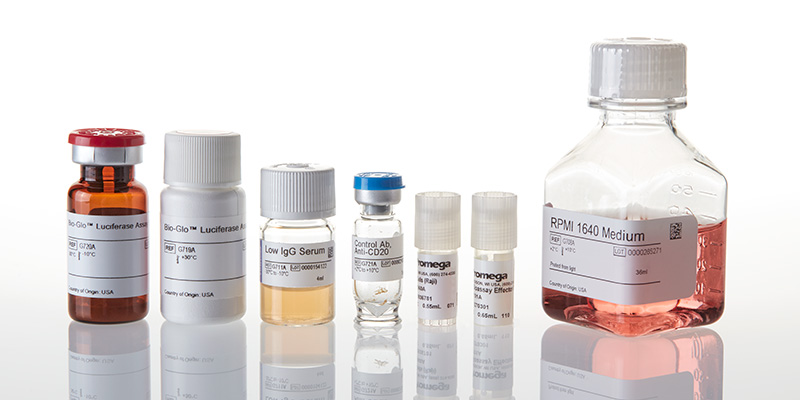Complete Kit: Everything you need to get started
*Core Kit: Used with customer-defined Ab and target cells
Target Kit: Control used with Core Kit
Also available in cell propagation model (CPM) forma
Background:
Fc receptor-mediated antibody-dependent cell-mediated cytotoxicity (ADCC) is an important mechanism of action (MOA) by which antibodies target diseased cells for elimination. The human FcyRIIIa gene displays a polymorphism in the position coding for amino acid residue 158. This translates to a higher affinity FcyRIIIa variant having a valine at amino acid 158 (V158) and a lower affinity FcyRIIIa variant carrying phenylalanine F158.
Classic methods used to measure ADCC use primary donor peripheral blood mononuclear cells (PBMCs) or purified natural killer (NK) cells that express Fc receptors on their cell surface. Killing of target cells is an endpoint of this pathway activation and is used in classic ADCC bioassays, which rely on donor peripheral blood mononuclear cells (PBMCs) or the natural killer (NK) cell subpopulation as effector cells isolated from blood donors.
These primary cell-based assays are highly variable in response, are tedious to prepare and can result in high background readings. The ADCC Reporter Bioassays overcome many of the limitations of traditional methods by eliminating the requirement for primary cell culture.
Description:
Antibody-dependent cell-mediated cytotoxicity (ADCC) is a mechanism of action of antibodies through which
virus-infected or other diseased cells are targeted for destruction by components of the cell-mediated immune system,
such as natural killer cells. The ADCC Reporter Bioassay (a–d) is a bioluminescent reporter assay for quantifying
biological activity on pathway activation by therapeutic antibody drugs in an ADCC mechanism of action (MOA) assay.
The assay combines a simple, add-mix-read format, effector cells provided in a frozen, thaw-and-use format, and an
optimized protocol for a bioassay that has low variability and high accuracy. Moreover the bioassay can be performed
in a single day. These performance characteristics make the bioassay suitable for applications across antibody drug
research, development and manufactured lot release. The thaw-and-use cells provided in the ADCC Reporter Bioassay
kits are generated under highly controlled conditions that drive low assay variability run to run, while providing the
convenience of an assay reagent that eliminates the need to propagate and prepare cells each time.
In addition to the ADCC Reporter Bioassay, Core Kit (Cat.# G7010, G7018), we offer two versions of a Complete
Kit: ADCC Reporter Bioassay, Complete Kit (WIL2-S), Cat.# G7014, and ADCC Reporter Bioassay, Complete Kit (Raji),
Cat.# G7015, in which we provide the target cells and Control Ab, Anti-CD20. We also offer the effector cells for
banking and propagation, the ADCC Reporter Bioassay, Cell Propagation Model (Cat.# G7102), under a unique
purchase agreement.
ADCC is a desirable mechanism for killing target cancer cells using antibody-based drugs. The antibody binds to
target antigens on the cell surface. When the Fc effector portion of target-bound antibodies also binds to FcγRIIIa
receptors on the cell surface of effector cells (natural killer cells predominantly), multiple cross-linking of the two
cell types occurs, leading to pathway activation of ADCC MOA (1). Killing of target cells is an endpoint of this
pathway activation and is used in classic ADCC bioassays, which use donor peripheral blood mononuclear cells
(PBMCs) or the natural killer (NK) cell subpopulation as effector cells (2). These cells can be highly variable in
response, are tedious to prepare and can result in high background readings.
The ADCC Reporter Bioassay uses an alternative readout at an earlier point in ADCC MOA pathway activation: the
activation of gene transcription through the NFAT (nuclear factor of activated T-cells) pathway in the effector cell (3,4).
In addition, the ADCC Reporter Bioassay uses engineered Jurkat cells stably expressing the FcγRIIIa receptor, V158
(high affinity) variant, and an NFAT response element driving expression of firefly luciferase as effector cells. Antibody
biological activity in ADCC MOA is quantified through the luciferase produced as a result of NFAT pathway activation;
luciferase activity in the effector cell is quantified with luminescence readout (Figure 1). Signal is high, and assay
background is low.
